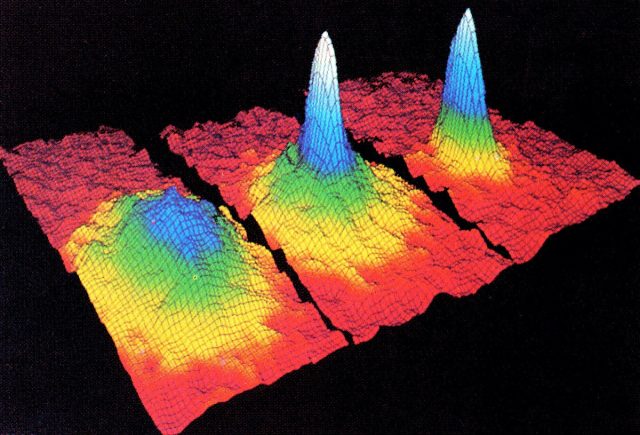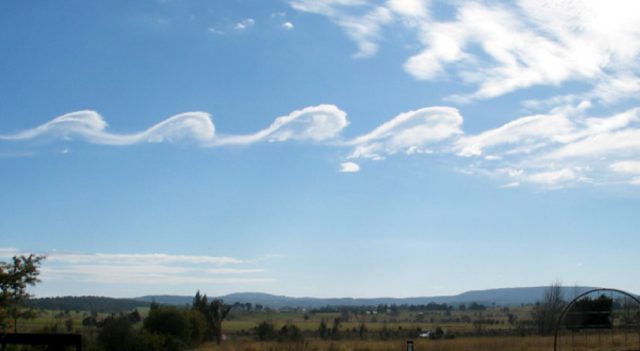MIT/Nature
Physicists at MIT have succeeded in getting “quantum tornadoes” to form in clouds of ultracold atoms, according to a recent paper published in the journal Nature. This is the first direct, in situ documentation of how a rapidly rotating quantum gas evolves, and per the authors, the process resembles how the rotational effects of the Earth can give rise to large-scale weather patterns.
The MIT scientists were interested in studying so-called quantum Hall fluids. First discovered in the 1980s, quantum Hall fluids are composed of clouds of electrons floating in magnetic fields. In a classical system, the electrons would repel each other and form a crystal. But in quantum Hall fluids, the electrons mimic the behavior of their neighbors—evidence of quantum correlation.
“People discovered all kinds of amazing properties, and the reason was, in a magnetic field, electrons are (classically) frozen in place—all their kinetic energy is switched off, and what’s left is purely interactions,” said co-author Richard Fletcher, a physicist at MIT. “So, this whole world emerged. But it was extremely hard to observe and understand.”
So Fletcher and his co-authors thought they might be able to simulate this unusual behavior of electrons using clouds of ultracold quantum gases. Known as Bose-Einstein condensates (BECs), these gases are named in honor of Albert Einstein and Indian physicist Satyendra Bose. In the 1920s, Bose and Einstein predicted the possibility that the wavelike nature of atoms might allow the atoms to spread out and overlap if they are packed closely enough together.
At normal temperatures, atoms act like billiard balls and bounce off one another. Lowering the temperature reduces their speed. If the temperature gets low enough (billionths of a degree above absolute zero) and the atoms are densely packed enough, the different matter waves will be able to “sense” one another and coordinate themselves as if they were one big “superatom.”

Public domain
The first BECs were created in 1995, and within a few years, more than three dozen teams had replicated the experiment. The Nobel Prize-winning discovery launched an entirely new branch of physics. BECs enable scientists to study the strange, small world of quantum physics as if they were looking at it through a magnifying glass, because a BEC “amplifies” atoms in the same way that lasers amplify photons.
Ultracold atomic gases are good at simulating electrons in solids, but they lack charge. That neutrality can make simulating phenomena like the quantum Hall effect a challenge. Putting a spin on such a neutral system is one way of overcoming this obstacle.
“We thought, let’s get these cold atoms to behave as if they were electrons in a magnetic field, but that we could control precisely,” said co-author Martin Zwierlein, also a physicist at MIT. “Then we can visualize what individual atoms are doing and see if they obey the same quantum mechanical physics.”
Using a laser trap, the MIT scientists cooled about 1 million sodium gas atoms; the cooled atoms were held in place by a magnetic field. The second step is evaporative cooling, in which a web of magnetic fields conspires to kick out the hottest atoms so that the cooler atoms can move more closely together. The process works in much the same way that evaporative cooling occurs with a cup of hot coffee: the hotter atoms rise to the top of the magnetic trap and “jump out” as steam.
Those same magnetic fields can also set the atoms within the trap spinning at around 100 rotations per second. That movement was captured on CCD camera, thanks to the way sodium atoms fluoresce in response to laser light. The atoms cast a shadow which can then be observed using a technique called absorption imaging.
Within 100 milliseconds, the atoms spun into a long, thin structure resembling a needle. Unlike a classical fluid (like cigarette smoke), which just keeps thinning, a quantum fluid has a limit to how thin it can get. The MIT researchers found that the needle-like structures that formed in their ultracold gases hit that thinness limit. The researchers described their spinning quantum gas and related findings last year in Science.

This latest paper takes the MIT experiment one step further by examining how the needle-like fluid might evolve under conditions of pure rotation and atomic interactions. The result: a quantum instability emerged, causing the fluid needle to waver, then corkscrew. Eventually, the fluid crystallized into a string of rotating blobs resembling tornadoes—a quantum crystal formed entirely from atomic interactions within the spinning gas. The evolution is strikingly similar to formations called Kelvin-Helmholtz clouds, in which a homogenous cloud starts forming successive fingers as a result of a velocity difference (speed and direction) between two wind currents in the atmosphere.
“This evolution connects to the idea of how a butterfly in China can create a storm here, due to instabilities that set off turbulence,” said Zwierlein. “Here, we have quantum weather: The fluid, just from its quantum instabilities, fragments into this crystalline structure of smaller clouds and vortices. And it’s a breakthrough to be able to see these quantum effects directly.”
Apparently, this behavior had been predicted in an earlier paper by other physicists, which the MIT team only just discovered. And there are some potential practical applications for this research, most notably as highly sensitive rotational sensors for submarine navigation. Submarines rely on fiber optic gyroscopes to detect rotational movement when they are submerged, which produces a telltale interference pattern. Atoms move more slowly than light, so a quantum-tornado sensor would be much more sensitive—possibly even sensitive enough to measure slight changes in the Earth’s rotation.
DOI: Nature, 2022. 10.1038/s41586-021-04170-2 (About DOIs).